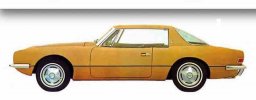Is there any way Studebaker could have made better marketing use of their war-time truck reputation in the post-war years? Maybe even internationally? Of course, I'd bet there were thousands of clapped-out Studebakers, GMCs, and IH's scattered across the globe too, to compete with...
A dressed up and tricked out 4x4 Studebaker as a competitor to the Jeepster and its kin.
Stude should definitely have capitalized on its wartime rep. A 4x pickup, akin the Dodge, or something like the (later) IH Scout, would have been an excellent idea. A *Travelall on the pickup platform wouldn't be a
bad idea...but I'm seeing something Scout-like as a more direct answer to the Jeep, one more civilized: wider track for better stability, hard body, actual doors, roll-up windows...
A Stude answer to the Ranchero? That should have (& easily could have) been carried over from the '39 ute, or restarted in '46 using the prewar car front half & pickup back half. If you want an AWD variant (not an off-roader, mind), even better.
Similarly, market a Packard V-12 engined car as a Packard "Mustang"?
Not as a 'stang, but certainly the T-bird. That might put pressure on Ford to go up-market with a 2-seat Merc or Lincoln 'bird, which IMO would have been an excellent outcome: keep the 2-seater in production as a premium product, & have the 4-seater as a Ford. That market would get big soon enough, if Packard could hold on.
A V-12 Packard engined vehicle at Indianapolis?
Put some combination of Studebaker/Packard on the early NASCAR circuit - with sufficient factory support. (Yeah, I know early NASCAR's popularity was mostly in the South, but it could help)
Both good ideas, IMO. Don't think there's only regional interest in NASCAR at play: there's national media coverage (if not TV in the '50s, or even '60s). Indy was national, too. Cummins got it right by trying to run a diesel (with a few problems). A Packard-Kurtis winner would have been great for Packard ads. (I confess I'm not sure the average Packard customer then would have cared, but given the need to attract younger buyers, that plus a T-bird could steal younger Cad & Buick/Olds customers {priced low enough, but not
too low; target the bottom Cad & top Buick/Olds, not the middle Buick, which the 120 did...}). If it had a 'glass body, like the Avanti, & beat Corvette to market...


(Does that prod GM to build the
F-88, too?

)
No-one says how much you have to pay in dividends, and good luck with suing anyone for reducing the dividend in the Great Depression.
Apparently from 1929-32 Nash paid out dividends equivalent to 89% of profits, GM paid out 93%.
Studebaker paid out 708%
Accumulated dividend payout of 30,952,276 on accumulated profit of 4,369,973. Nash paid out less than that on profits of 32M!
For 1930 Erskine paid out 7.5M on profits of 400K, which is nearly 2000% of profits
A million paid out in 1932, on a loss of five million
So in fact it was even worse than I remembered, Studebaker paid out 26M more than they would have if they did the same 90-100% of profit ratio the other two did. Bear in mind 1932 sales were roughly 38M.....
I knew Erskine had overpaid, but this is nuts.😱😱
Who pays dividends on
losses?


As for independent, I also have my doubts they can survive alone, much as I wish they could. I'd suggest the OTL Stude-Packard merger instead also include Kaiser & Willys; maybe instead of the Kaiser-Graham deal (& Kaiser was no help to Graham, really), make it a four-way Packard-Stude-Graham-Willys merger? (That seems to require a fair bit of foresight...) That gives you the Stude & the Jeep rep (& sales!), plus the Packard cachet, plus the wartime money from Packard & Willys, & Packard's high-quality engineering.
My proposal, move Studebaker to Canada in the mid-1960s per OTL. Continue making
Canadian Larks, find an engine, and ideally a new buyer for the company. Sign a US distribution agreement with AMC or another dealer network. Next, design and produce a fuel efficient, modern compact in time for the 1973 fuel crisis.
Studebaker should also use its Auto Pact cross border trade advantages to partner with European or Japanese brands. Instead of Volvo assembling their cars in
Nova Scotia, Canada they can have Studebaker in Hamilton, Ontario make them. And there’s British cars that are getting killed by the high Pound and US import tariffs. Assemble the new monocoque
Triumph 2000 and Spitfire (or TR6) at Studebaker to enable easy access to the US market. Best of all would be Studebaker gaining access to the superlative
Rover (ex-Buick) small block V8.
That suggests you've butterflied Bricklin. (Come to that, he might end up working for *AMC.) Nova Scotia's probably less inclined to give tax breaks to a major auto company than a startup, but might still give some...
If alt-Stude's still around, it might well buy the 215 Buick design directly, rather than get it second-hand from Rover... Even if Stude built it with iron block & head, to avoid Buick's problems with aluminum, it was better than what they had. Put it in the Lark/Hawk.

